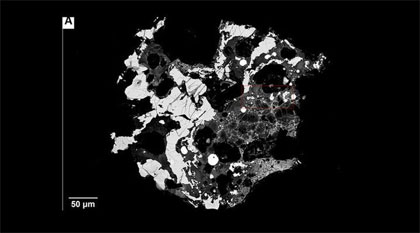
Scientists believe that ancient alien technology was discovered in Siberia
By Anomalien.com
On May 15, 2022
In 2014, NASA published a book looking at extraterrestrial intervention in human history. It explores the possibility that some of the rock art on Earth may be of extraterrestrial origin.
Moreover, in 2009, scientists found an unknown mineral in Siberia that arrived on Earth 4.5 billion years ago, that is, when the solar system was just being formed.
This rare but strange piece of material was found in a box received from the Italian Museum of Natural History in Florence.
According to an international team of researchers led by scientists from Princeton University, he arrived on Earth with the Khatyrka meteorite, which fell near the Koryak Mountains in Eastern Siberia. When scientists analyzed the mineral, they were not intrigued by its age, but by its atomic structure.
The structure of this mineral has never been found in nature before, although it was artificially created in the laboratory. They are known as “quasicrystals” because they look like crystal on the outside but are noticeably different on the inside.
The researchers studied a small fragment of the mineral. The atoms of matter were arranged in a wide variety of configurations that, based on human understanding of science and chemical composition, were simply not possible in nature.
 Quasicrystals have their own dramatic history. Dan Shechtman grew the first quasicrystal in 1982, a discovery so controversial that he was simply asked to leave the research lab. But the evidence was overwhelming: it was a new type of material. Shechtman was awarded the 2011 Nobel Prize in Chemistry for his discovery.
Quasicrystals have their own dramatic history. Dan Shechtman grew the first quasicrystal in 1982, a discovery so controversial that he was simply asked to leave the research lab. But the evidence was overwhelming: it was a new type of material. Shechtman was awarded the 2011 Nobel Prize in Chemistry for his discovery.
The concept of quasicrystals was first introduced in 1984 by Steinhardt and Dov Levin, then working at the University of Pennsylvania. When the team discovered that the meteorite contained this mysterious, ancient and intricately engineered material, they declared that it could indeed form naturally.
“This discovery provides important evidence that quasicrystals can form in nature under astrophysical conditions and suggests that this phase of matter can remain stable for billions of years,” said physicist Paul Steinhardt, Albert Einstein Professor of Natural Sciences at Princeton.
Technically, scientists describe quasi-crystals as quasi-periodic, hand-placed, which are no longer on the periodic table. Although they show a pattern that continuously fills all available mass, they lack what scientists and mathematicians call “translational symmetry.”
Ufologists and scientists previously assumed that it was in such forms that evidence of extraterrestrial life would be found. Pointing out that quasicrystals, being a new form of matter, should actually be considered as artifacts of artificially created alien technology.
However, no one has been able to explain how these quasicrystals can be formed by natural processes, and hardly anyone will do it. Their “forbidden symmetry” makes it impossible for them to form naturally. Other known quasicrystals, apart from those found in meteorites near the Koryak Mountains, have recently been synthesized by scientists in the laboratory.
Being very hard, with low friction characteristics, as well as low thermal conductivity, quasicrystals are a very useful product used in a wide range of high speed technologies such as aircraft coatings and stealth fighters.
In 2017, a team from the Geological and Planetary Sciences Think Tank at the California Institute of Technology discovered 35 new minerals in the Khatyrka meteorite. Site director Chi Ma said “we usually don’t see” such an aluminum-rich metal in space rocks because the aluminum would have reacted to form alumina.
He said that the Khatyrka meteorite is the only meteorite ever found that contains aluminum metal. A meteorite fragment containing a trio of new minerals is now in the holdings of the Smithsonian Institution’s National Museum of Natural History, which maintains a catalog of more than 600,000 specimens.
If this material had not been created by nature, as some claim. Where did this mysterious material come from and how did this complex material end up inside an ancient meteorite?





















